Japanese Wolves – Part III: The Ezo Wolf
Posted by: Loren Coleman on June 17th, 2009
Japanese Wolves
Part III – The Ezo Wolf
by Brent Swancer
The Honshu wolf is the most relatively well known type of wolf of Japan, but it was not the only one. The cold, northern Japanese island of Hokkaido, as well as Sakhalin, the Kuril islands, the Kamchatka Peninsula, and the Iturup and Kunashir islands, were the domain of the Hokkaido wolf (Canis lupus hattai, formerly known as Canis lupus rex), also known as the Ezo wolf.
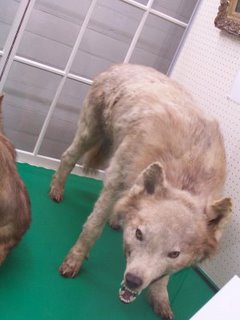
Ezo wolf.
The Ezo wolf was a distinct subspecies, and had a more traditionally wolf-like appearance than its southern cousin, the Honshu wolf. The skull was large and formidable, with long, curved canines, and the body dimensions were similar to that of grey wolves. The Ezo wolf was typically grey in coloration, and significantly larger than the wolves of Honshu. Like the Honshu wolf, the Ezo wolf descended from Siberian wolves from the Asian mainland, yet the Hokkaido subspecies retained a size closer to these large ancestors.
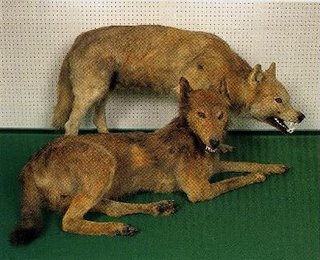
Ezo wolves.
The retention of large size in the Hokkaido wolves is likely due to a variety of factors. The higher latitude environmental conditions of Hokkaido more closely resemble those of Siberia, favoring the retention of a robust build like that of the Siberian wolves. Prey in Hokkaido was bigger as well. Some prey species, such as the now extinct red deer and Hokkaido deer, were significantly larger than the subspecies of the other Japanese islands, making size an advantage for the wolves.
In addition, there was likely a more prolonged intermingling between the Ezo wolves and their Siberian wolf progenitors. While the Honshu wolf evolved in relative isolation in the south, growing smaller and more dog-like due to a variety of new environmental pressures, the Ezo wolf in the north was able to further interbreed with Siberian wolves in a habitat similar to that of their ancestors.
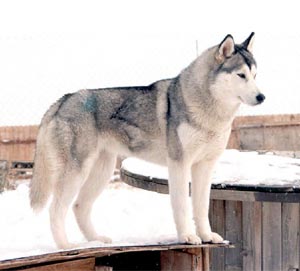
Siberian husky dog.
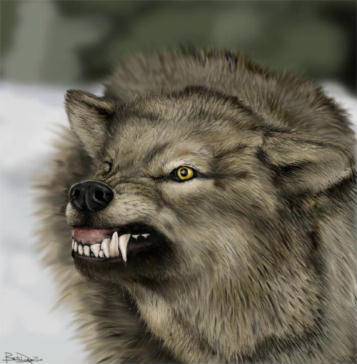
Siberian wolf (an Asian variety of timber wolf).
The Ezo wolves were highly venerated by the indigenous Ainu people of northern Japan. These wolves were considered to be powerful and high ranking gods, along with bears and owls, and feature highly in Ainu myths, folklore, and poems. They were known by many names to the Ainu, Horkew Kamuy (Howling God), Yukkoiki Kamuy (The God Who Takes Deer), Horkew Retara Kamuy (White Wolf God), and Horkew Kamuy-dono (Lord Wolf God). To this day, many landmarks bear Ainu names pertaining to wolves.
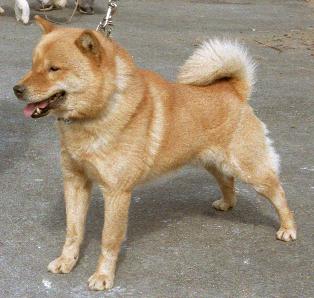
Ainu inu.
Again like bears and owls, the Ezo wolves were often used in a ritual known as iomante, or “sending away ceremony.” In this ceremony, bears, owls, or wolves would be tied up and tormented with sharp sticks before finally being killed. The Ainu believed that wolves were powerful gods, and that the only way their souls could be released and returned properly to their realm was to cause great pain and suffering before death. It may sound horrible to most Western readers, but from the Ainu’s point of view it was a great honor and courtesy for the animal. Iomante was in fact one of the only acceptable ways of killing the wolves. It was not permitted to kill them by poison arrows or firearms, as it showed disrespect. Furthermore, even when properly killed, any Ainu who wasted the meat or pelt of a dead wolf was said to be hunted down by the remainder of the pack.
The Ezo wolves were highly regarded for their hunting prowess, and there are many accounts of the Ainu seeking to domesticate them. This practice was confirmed by several surveys by the Hokkaido Development Agency, which found some Ainu villages actively raising wolf cubs. After being raised among the villagers for around two years and becoming accustomed to people, the wolves were then supposedly used as hunting companions, or released to go hunt deer for the village on their own.
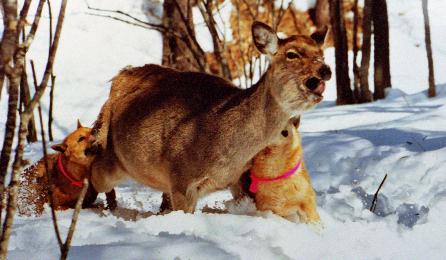
These wolves tended to be difficult to train, yet the Ainu so valued their hunting abilities that they also tried to reproduce these qualities in their dogs. It is documented that the Ainu would intentionally breed their dogs with the wolves to this end and the practice was so common in some areas that there are reports that mention wolves loitering near villages when dogs were in heat. This practice of interbreeding dogs and wolves is thought to have contributed in part to the development of the Ainu ken breed of dog (known more commonly in Japan by its official name, the Hokkaido inu), well known as a formidable hunting dog.
Despite this high standing among the Ainu, inevitably it was modernization that led to the Ezo wolf’s demise.
After the collapse of feudal government in 1868, Japan started to turn to the West for help in modernizing the nation. The government became convinced that ranching was the key to Hokkaido’s agricultural prosperity. An American from Ohio by the name of Edward Dun was recruited by the Japanese to teach ranching techniques to Hokkaido farmers and kick start the industry.
Horse and cattle ranches began popping up all over Hokkaido, throwing humans and wolves into contact with growing frequency. Unfortunately, in addition to bringing American ranching approaches to Japan, Dun also had brought with him American negative attitudes towards wolves. It was not long before tensions rose and the wolves were seen as a threat to the booming ranching industry taking hold of Hokkaido. Dun suggested that a strychnine poisoning campaign be launched against the wolves. Before long, a bounty system was also put into place by the Hokkaido Development Agency to speed things along, and the wolves were actively slaughtered. The numbers of Hokkaido wolves plummeted with frightening speed.
In 1889, within just 20 years of the start of the poisoning campaigns, the Hokkaido wolf was considered extinct.
The Ainu have long held that the wolf existed well past this date, and even to this day sightings reports come in occasionally. On rare occasions, ranchers in modern times have complained of mysterious killings of their livestock caused by some kind of wild animal. Hikers and hunters have reported wolf howls as well.
Could the Ezo wolf still be out there?
Many sightings are dismissed on similar grounds as Honshu wolf sightings, with skeptics arguing that eyewitnesses are seeing wandering or feral wolf-like breeds of dogs such as huskies, malamutes, or Hokkaido ken dogs that might resemble Ezo wolves under the right circumstances.
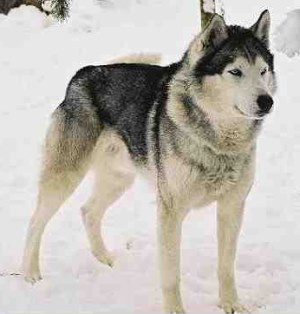
Siberian husky.
The thought of huskies wandering around in the wilds of Hokkaido is not as far fetched as some may think. Some years ago there was a huge Siberian husky boom in Japan, and many less than reputable breeders were pumping them out as fast as they could to meet demand. Unfortunately, as is the case with many pet booms in Japan, as soon as the popularity wore off people wanted the next big thing.
In the city, huge numbers of these dogs were euthanized or given to shelters. In the case of some more rural areas, people often merely went out into the woods and simply abandoned the dogs. Considering the pet situation went from huskies all over the place to scarcely any at all, it seems at least plausible that a number of these sturdy, cold adapted dogs could have ended up feral in Hokkaido. A husky could feasibly be mistaken for a wolf. Mounted samples of Hokkaido wolves are extremely rare, and photos of living animals are not available. Many people have no idea what they actually looked like and may assume they were identical to the grey wolves they know about. Considering this, perhaps after seeing something like a husky out in the wilderness, an eyewitness could jump to the conclusion that it was a Hokkaido wolf they saw.
Sightings of Hokkaido wolves are not particularly common, but could it really be merely dogs people are seeing? It’s difficult to say.
Besides sightings, other evidence is scant. There are no known photographs of surviving Hokkaido wolves and physical evidence such as hairs or prints are extremely scarce. Some think that the chances of the Ezo wolf’s survival is slim. They argue that the poisoning campaigns were too shockingly effective, the extermination too swift and thorough to have left any alive. However, much of Hokkaido remains remote and inaccessible and perhaps could have offered refuge to a small population.
If the Ezo wolves are indeed gone, it would be a deep shame. The spectacular vistas of this land would seem somewhat incomplete without them. Hokkaido is a wild place that still looks and feels very much like a land inhabited by wolves. Perhaps it still is.
END
About Loren Coleman
Loren Coleman is one of the world’s leading cryptozoologists, some say “the” leading living cryptozoologist. Certainly, he is acknowledged as the current living American researcher and writer who has most popularized cryptozoology in the late 20th and early 21st centuries.
Starting his fieldwork and investigations in 1960, after traveling and trekking extensively in pursuit of cryptozoological mysteries, Coleman began writing to share his experiences in 1969. An honorary member of Ivan T. Sanderson’s Society for the Investigation of the Unexplained in the 1970s, Coleman has been bestowed with similar honorary memberships of the North Idaho College Cryptozoology Club in 1983, and in subsequent years, that of the British Columbia Scientific Cryptozoology Club, CryptoSafari International, and other international organizations. He was also a Life Member and Benefactor of the International Society of Cryptozoology (now-defunct).
Loren Coleman’s daily blog, as a member of the Cryptomundo Team, served as an ongoing avenue of communication for the ever-growing body of cryptozoo news from 2005 through 2013. He returned as an infrequent contributor beginning Halloween week of 2015.
Coleman is the founder in 2003, and current director of the International Cryptozoology Museum in Portland, Maine.










I do hope there is even a small population still there, but generally when you have the top predator competing with man…the result is usually going towards the predator wiped out. Specially with the interaction between man and wolf before the campaigns began, there would be no reason for the wolves to think there would or should be any danger of anything that man put out. Well, here’s to positive thinking…They are probably still alive and learned to stay away from man.
Another excellent piece, Brent. Fascinating stuff. Haven’t Huskies been used in films as wolf stand-ins in the past?
I find it fascinating how humans seem unable to even keep coyotes from increasing their numbers, despite incessant persecution; wolves can practically eliminate coyotes where the two come into conflict…yet humans can easily eradicate wolves when they half put their minds to it. And the wolves stay gone. Or at least they seem to take their time about coming back.
Kind of like the sports phenomenon known as “matchups:” Team A beats Team B almost constantly; Team B beats Team C almost constantly….yet Team C consistently beats Team A. I’ve never understood it. How do you do it, Coach? Well, we just match up well against them! Oh. OK.
Apparently feral domestic pigs revert to the pure wild Sus scrofa form over the course of generations. Wonder what a population of feral huskies or inu would look like in a few hundred years.
M_m: could you tell us more about the deer hunting photo, and about the Ainu practice? What’s going on there? Is the intent for the animals to bring the deer to bay or actually kill it themselves?
This is really cool. Thanks!
very interesting, thank you!
about the feral huskys…it is my understanding that domesticated dogs fare very poorly without a human propogated food source and that viable feral breeding populations are short-lived. if this is true, sustained feral dog sightings in wilderness areas would be unlikely. i would expect some around settlements, but not for prolonged periods without new individual animals being introduced from domestication. i would also believe that feral dogs would gradually become somewhat desensitized to a human presence near the food source, thus leading to more frequent and confirmable sightings.
basically, i find huskys from puppy-mills to be unlikely culprits.
The apparent about-face on the Ezo wolf seems odd. It went from a revered animal to being ruthlessly exterminated. Were the Ainu a separate group from the ranchers? Did the Ainu continue to revere the wolves, and the ranchers simultaneously proceed to destroy the wolves?
Great new post, Brent.
Hopefully the Ezo really did survive somewhere in Japan.
Solitaryman asked a very good question. Wonder what triggered the “about-face” on the Ezo. Probabaly it was the fact that religious tradition came in contact with “cold reality”.
Some responses.
DWA- The Hokkaido breed often is tasked with killing the animal themselves. They kill by throwing down the prey and destroying the nerve system at the shoulder of the front leg. This breed of dog never eats their prey, and will keep it safe until the hunter can retrieve it. These dogs were used to hunt all sorts of big game, including bear. Their usefullness didn’t stop there either. Their bold, alert, and cautious nature makes them good village guard dogs, and they were used as draft dogs as well.
maeko- Actually, feral dogs can breed and establish long term populations quite well in the wild. It has been found that the duration and intensity of domestication isn’t always a good indication of an animal’s feral potential. Just look at the dingoes of Australia. There are mulitigenerational feral dog populations in Asia, Australia, even America. They can actual be quite an ecological hazard in some areas.
There have been areas where the feral populations have moved more away from human populations as well. For instance, in the Sikkim region of the Himilayas, there have been problems with feral dog populations that have begun to make the forests their habitat, threatening native species. Feral dogs can potentially survive wherever there is a habitat and food source.
Interestingly, feral dogs over several generations will start to exhibit certain “pariah” dog traits, taking on an appearance much like the dingoes of Australia or the Carolina dogs of America. Whether puppy mill huskies have established populations in the wilds of Hokkaido remains to be seen, but it is not entirely out of the realm of possibility in my opinion.
solitaryman, cryptidsrus- The Ainu certainly had nothing to do with what the ranchers were doing. The Ainu people are the indigenous people of Japan, much like the Native Americans of America. They revered the animal, yet modernization changed the views of non-Ainu, who then went about the extermination when wolves were seen as a threat to their livlihood. The Ainu did everything they could for the wolves, but the ranching industry could not be stopped.
So yes, the Ainu are a separate group and they continued to revere the animals even as modernization simultaneously destroyed them. You can look at it sort of like Native Americans when white settlers were killing off their animals such as wolves and bison.
DWA- I thought I should make one thing clear with my above post. While the Hokkaido inu is traditionally expected to make their kills themselves, there are exceptions. I’m sure some modern day hunters who use these dogs for hunting may opt to have them just bay the animals in order to prevent injuries to these rather expensive animals. However, the breed’s instinct is to make the kill and hold it.
As for the bears I mentioned, I’m fairly certain that the dogs were used only for baying the animals. This stems not only from the danger posed by the power of a 650 pound bear, but also from the fact that bears were worshipped by the Ainu. As with wolves, there are certain proper ways to go about killing bears in Ainu culture.
maeko- One more thing about feral dogs and how they relate to modern day wolf sightings. I tend to think that if there were feral huskies seen near human settlements, they might just be seen as what they are, huskies. One of the dangers of feral dogs is actually that people tend to view them as just roaming house pets and don’t consider their reversion to a more wild state. One the other hand, a feral husky in the wild where one did not expect to see it might instigate a wolf sighting. So it might just depend on the circumstances behind the sighting. A husky in a dumpster is a husky, but one out running through the forest in the middle of nowhere becomes “a wolf.”
As I said, there are quite a few populations of multigenerational feral dogs throughout the world, so it is one angle to consider I think.
Just some thoughts.
m_m: the bring-to-bay bear dog doesn’t seem to be restricted to one part of the world either. The more I look at these dogs, the more they look like Norwegian elkhounds, of which we owned one when I was young. They were bay dogs, but they bayed everything including bear.
It’s funny, for me, that this discussion has taken a turn into “pariah” dogs at the point I revisit it.
Just a few minutes ago, on our way home, my three kids and I saw a doglike animal, between fox and coyote size, bolt across the road in front of us. It looked, to me, quite unlike a domestic dog, certainly unlike any dog I had ever seen around our home in Maryland. It looked like a fox might look with its coat removed, i.e, skinny frame and tail, but with longer legs. It also didn’t behave like I would expect a domestic to based on experience. The road we were on is pretty quiet, even in daylight. This was at night, which allowed me to make numerous passes of the area. On each one we saw the dog, which seemed to be going back and forth across the road and always trying to evade us. It never came near to staying still enough for me to get a good look. But I kept thinking: classic pariah dog.
The toughest thing to do with any extant cryptic wild canid in Japan, on any of the islands, if such there be and it almost seems the way to bet, may be figuring out what, exactly, it is. It’s an old story, the “stray” dog, and it seems to happen everywhere dogs have gone.
thanks mystery man!
darn…i guess i really DO have to worry about packs of feral dogs running on my farm property! haven’t had many, just a couple of packs of 3 to 4. hoped they would die out having to compete with coyotes (and me, for that matter). now that you bring it up, there is a dog, supposedly found wild and definately bred, called the Carolina Dingo. i think it is supposed to be desended from the dogs kept by native americans in the area. looks kinda like a coyote.
What a lively, interesting discussion. I am just eager to dive into this one with all four feet! If I ever catch that elusive lull in the mad dash around here I’ll pop in on this one.
You are so right mystery_man, I would rather observe, study, and discuss canids and felids and other carnivores of course, than all the lake monster in the forests or all the bigfoot in Loch Ness.
Kittenz- I’m very pleased that you have enjoyed these pieces on the Japanese wolves, and I always appreciate the extra insights and information you bring to the table. This stuff fascinates me as well. 🙂
MM: before the topic fades into the sunset, though only tangentially related, the subject of Raccoon dogs, Tanuki’s, came up in Andrew Leonard’s column at Salon online. NO idea why it was of interest to him, aside from every technogeeks interest in all things about japanese folklore (Miyazaki and anime? perhaps)but he describes ’em and links to a page at japanese pop-culture blog, pinktentacle, which has an interesting set of woodcut prints from 19th century artist Kuniyoshi. The legendary properties of the racoon dog’s scrotum is displayed hilariously!
And as always, appreciate the story and your perspective on both the folklore and natural history. cheers.
Dogu4- Yes, it does appear this topic has faded into the sunset, sadly. 🙁
The tanuki is a very interesting example of a very real animal being at the center of a large amount of folklore and possessing a good deal of mythical qualities not the least of which is the scrotums you mention. I suppose the same could be said of the Japanese wolves, real animals so steeped in folklore that one who didn’t know they actually existed might be inclined to think they were merely phantoms of the human imagination.
Thank you for bringing that link to my attention. The Pink Tentacle, by the way, is an excellent site for not only Japanese pop-culture, but also cryptozoological and mysterious phenomena in Japan as well.
Glad you enjoyed the article here!